FDA VRBPAC Meeting on Booster & Vaccine Variant Policy
Tagged:COVID
/
PharmaAndBiotech
/
Politics
This week the FDA’S Vaccines and Related Biological Products Advisory Committee (VRBPAC) met to consider future policy for vaccine boosters and variants for the future.
Sources
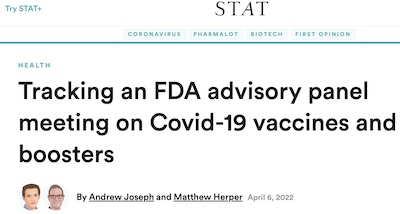 We’ll start out with our usual safari guides at STAT News, Andrew Joseph & Matthew
Herper, who live-blogged the hearing. [14] They tell of
some of the expected arguments, i.e., “why are we here when you authorized boosters last
week?” (And, of course, when the sound cut out: “What’s the point of having public VRBPAC
hearings if the public can’t hear the discussions?” Also, some nice kvetching about the
FDA’s choice of hold music, which I found for some reason entirely amusing.)
We’ll start out with our usual safari guides at STAT News, Andrew Joseph & Matthew
Herper, who live-blogged the hearing. [14] They tell of
some of the expected arguments, i.e., “why are we here when you authorized boosters last
week?” (And, of course, when the sound cut out: “What’s the point of having public VRBPAC
hearings if the public can’t hear the discussions?” Also, some nice kvetching about the
FDA’s choice of hold music, which I found for some reason entirely amusing.)
But of course real primacy must go to the primary sources, the FDA itself and the presentations to the VRBPAC:
- The meeting announcment page [1] contains a video feed for those who feel compelled to watch every detail, and links to all the briefing documents and slide decks.
- The official briefing document, written by FDA staff, summarizes what’s on their mind
and the subjects on which they would like to take expert advice. [2]
They summarized the issues thusly:
While modification of a monovalent Covid-19 vaccine to be more closely aligned to a specific variant may improve vaccine effectiveness against that variant, it is not known whether such modification might come at a cost of reduced breadth of coverage and potentially decreased effectiveness against variants that might emerge in the future. Depending on the evolution of the virus and the epidemiology of circulating variants, a multivalent vaccine … may offer benefit over a monovalent vaccine.
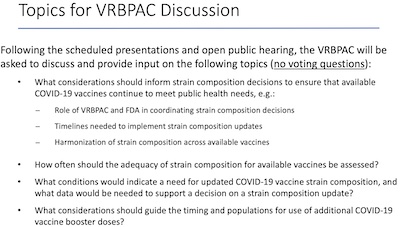
- The official questions the FDA put before the VRBPAC, shown here. [3] Note it says explicitly there are no voting questions to be decided here, they just want to hear expert discussion on what future policy options they have. (Though we, and they, decided to add: “How much international coordination is needed vs going one’s own way in an emergency?”)
- An FDA-authored presentation on the “framework for future decisions” on the 2 main issues here: when to authorize boosters, and what strain(s) to put in boosters (monovalent vs polyvalent like modern flu shots). [4]
- An FDA-authored proposal for particular decision procedures (committees and such) for vaccine strain composition. [5] This is kind of a bureaucratic thing, but at least they’re trying to get it out of the way in advance.
That’s the ex officio FDA input to the meeting. The external advisors, of course, had much to say as well:
- A presentation on SARS-CoV-2 viral evolution under population immune pressure [6], because nothing is ever allowed to be simple and easy.
- What appears to be a use of either singular value decomposition or multidimensional scaling to represent the angigen space in a way to call out differential antibody response. [7]
- A COVID-19 model from the Institute for Health Metrics and Evaluation @ University of Washington [8], containing the most complicated SIR model I’ve seen to date (and yes, I’ve seen the SIDDARTHE model).
- The star of the show, for my money, was an empirical study of the efficacy of a 4th dose in Israel. [9] We’ll look through some of the problems, but this is as close as you’re gonna get to somebody telling you what’s likely to happen with another booster, and is apparently what drove the FDA authorization for them.
- Announcement of a WHO Technical Advisory Group on COVID-19 Vaccine Composition [10], the main innovation of which, as far as I could see, was the acronym WHO TAG-CO-VAC.
- A CDC update on the epidemiology of SARS-CoV-2 strains. [11]
- A CDC update on the vaccine efficacies. [12]
- A set of considerations on choosing booster strains, combinations, and timing based on manufacturing requirements. [13] The main point here was that we can’t wave a magic wand and decree fiat boosters; somebody has to make them (with all the supply chain problems) and then distribute them, warehouse them, make an adequate cold chain, educate healthcare providers, pay for them, and so on. Not as interesting as the basic science, but any one of these can stop you cold, so it’s nice to see at least pro forma attention being paid.
Lots of stuff to look through, so we’ll look at the slides and the opinion of our safari guides to see what’s worth looking at.
The High Points
SARS-CoV-2 Evolution Under Population Immune Pressure
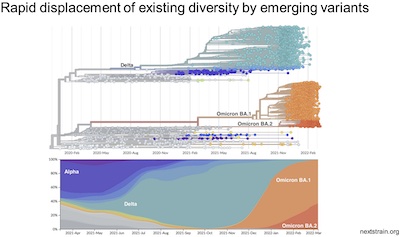
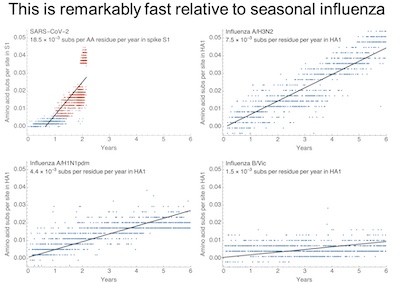
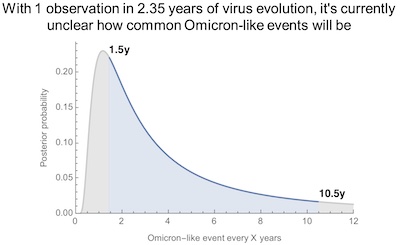 Trevor Bedford, of the Fred Hutchinson Cancer Center & Howard Hughes Medical Institute,
had a summary of the evidence on SARS-CoV-2 evolution, as the human population becomes
more immune via vaccination and prior strain infections. The high points, as I saw it,
were:
Trevor Bedford, of the Fred Hutchinson Cancer Center & Howard Hughes Medical Institute,
had a summary of the evidence on SARS-CoV-2 evolution, as the human population becomes
more immune via vaccination and prior strain infections. The high points, as I saw it,
were:
- The data from nextstrain.org shows SARS-CoV-2 mutation is
extremely rapid and new strains overwhelm previous strains. A variant will drift for a while, but
then get bigfoot-stomped by a new variant. The first slide reproduced here shows the
cladogram (“viral family tree”) showing how Delta and Omicron are unrelated. Below that
we see the abundance in patient samples:
- Alpha was the big noise in early 2021
- Then Delta bigfoot-stomped it out of existence in midsummer 2021
- Then Omicron/BA.1 even-biggerfoot-stomped it out beginning late 2021
- … and now Omicron/BA.2 strain is biggest-foot-stomping even that.
- We can compare this against various types of influenza, the previous record holder for
serious human-infecting viruses with annoyingly high mutation rates. In all 4 plots on this slide,
they’ve plotted the number of amino acid (AA) substitutions per unit length in the spike
protein for SARS-CoV2 and the equivalent for influenza. At least 2 things stand out to
me:
- The mutation rate in SARS-CoV2, ($18.5 \times 10^{-3}$ subs/AA/year), is about 2.5 - 12.3 times faster than influenza!
- In the upper left plot, the cloud of orange points at the top is Omicron: Omicron stood out as having a monster number of mutations, over and above the already-high mutation rate in SARS-CoV-2!
- Finally, with admittedly scant data, they estimated what appears to be a Poisson distribution for the probability of getting a new Omicron-like event every so many years. The median was 1.5 years, and the (possibly 95% probability?) credible upper limit was 10.5 years. So while there’s a lot of uncertainty there, we should plan for this happening again, every couple years. Better to over-prepare and be wrong, than have another pandemic that kills another few million: public health, when successful, always looks like over-preparation.
COVID-19 Vaccine Efficacies
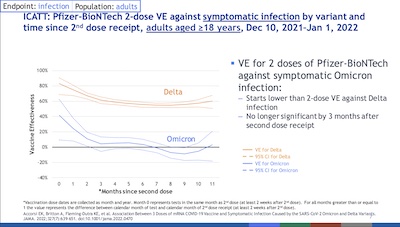 LCDR Ruth Link-Gelles presented some sobering data on the need for boosters, documenting
a decline in efficacy between Delta and Omicron that basically wipes out the primer
series.
LCDR Ruth Link-Gelles presented some sobering data on the need for boosters, documenting
a decline in efficacy between Delta and Omicron that basically wipes out the primer
series.
There’s a lot here, but I’ve extracted just 1 slide showing all age group efficacies vs infection for Delta and Omicron. (There’s other data on severe disease, hospitalization, and death, with age stratifications. This just a simple way to make the main point; the other data back up against the usual objections.)
The point:
- Over time, VE for 2 doses declined against Delta somewhat (80% down to 60%).
- That might have been enough to justify a booster, but check out what happened to Omicron: VE decined in 2 months down to indistinguishable from 0%!
This is excellent evidence that a 2-dose primary series is just ineffective against Omicron. The first booster was an excellent choice, in retrospect. (It doesn’t say anything about a 2nd booster, so we’ll look at other data below for that.)
Update on Epidemiology of SARS-CoV-2 Strains
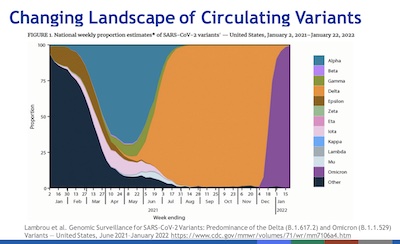
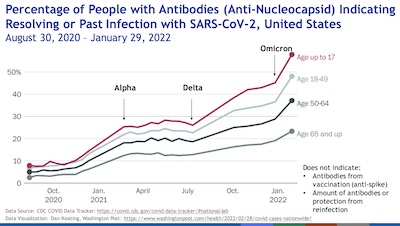
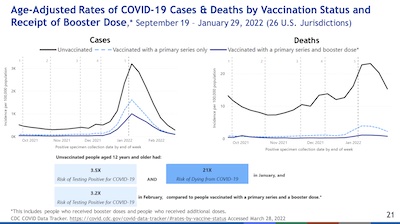 CDR Heather Scobie of the CDC presented a boatload of data on the epidemiology of
SARS-CoV-2 strains over time, as well as the case rates and death rates. While there’s a
lot here, I came away with 3 impressions:
CDR Heather Scobie of the CDC presented a boatload of data on the epidemiology of
SARS-CoV-2 strains over time, as well as the case rates and death rates. While there’s a
lot here, I came away with 3 impressions:
- In the 1st slide shown here, we see color-coded fractions of patients with each strain. You can see that ast the start of 2021, Alpha (in blue) was on its way to dominance. Then came the bigfoot-stomp of Delta (orange). Then came the biggerfoot-stomp of Omicron (purple). (These data cut off too soon to see Omicron/BA.2.) This is in exact agreement with Bedford’s data above.
- They measured the fraction of people with nucleocapsid antibodies to SARS-CoV-2. This
means, roughly, “not spike protein antibodies” so we know it’s not from vaccination.
This is a reasonable measure of who’s had prior infections. In the 2nd slide shown
here, it’s plotted versus time, and stratified by age groups.
- It’s lower among the older cohorts, as we’d expect from (a) higher vaccination rates (less likely to have been infected) and (b) higher death rates (less likely to have been around for post-infection sampling). This is… an unpleasant truth.
- More to the point, the cohort most likely to be carriers (the young) are rising over time. If 50% of the young have had COVID-19 already, then it’s that much harder for a new wave to start due to prior infection immunity. This is… a rather more hopeful truth, that we’re now in the burned-over district and thus less subject to further SARS-CoV-2 evangelization.
- Finally, consider the 3rd slide here: case rates and death rates versus time, stratified
by vax status (unvax, primary only, and boosted).
- The plot on the left shows that Omicron did indeed cause a fair number of breakthrough infections in the vaccinated, though nowhere near the infections in the unvaccinated.
- Even more sadly, consider the death rates on the right: the vaxed, and especially the
boosted, barely budged in their death rates. The unvaxed death rate soared.
Omicron was a disaster for the unvaccinated, and it did not need to happen! This is the fruit of the poisonous tree (a position taken by irrational means) of vaccine disinformation: misery and death. “Get vaccinated, or die” is more or less the message.
SARS-CoV-2 Antigenic Space
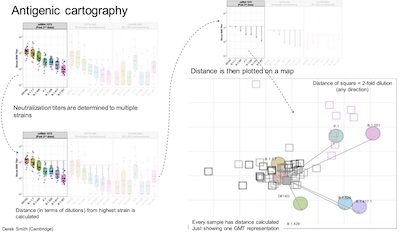 The Beigel study from NIAID was interesting, but frustrating.
The Beigel study from NIAID was interesting, but frustrating.
They’re trying to use data to guide strain selection for the next vaccine booster, which is of course an important problem and one of the reasons for this meeting. In principle, I like their method, which is apparently in use for influenza vaccines:
- They measure the levels of antibodies required for neutralization of each strain, and calculate the distance from the highest strain. Repeat this for each relevant type of antibody/vaccine/convalescent serum to get multiple types of distances.
- In principle, there’s some high-dimensional space in which each strain is a point and the measured distances are the Euclidean distances. They reduce this to 2 dimensions, but do not specifiy their method. (The usual ones would be multidimensional scaling or taking the first few factors in singular value decomposition. I’ve happily used both methods in the past, so I’m a bit frustrated at the math being so suppressed I can’t see what’s going on. Although, the biologists and MDs would probably be allergic to the math, so as per usual, there may be no happy medium here.)
- Then in the veritcal dimension they show the GMT (geometric mean titer required for neutralization), to get a surface. The high parts of the surface are the danger zones, so you want to be sure you cover those.
So in principle I love this: it’s a data-driven, quantitative method for strain selection. Unfortunately:
- For math geeks like me, there are no equations and no statistical methods cited for the dimension reduction, or the significance of distances on the antigenic surface. So it’s hard to trust the method, and it didn’t call out a clear conclusion anyway. I say this sympathetically, because I’ve been there personally: too much math alienates all the biologists and executives, but too little alienates all the statisticians.
- For the bio/med geeks on the VRBPAC, the conclusion was the same but the reasons were
different. They saw a lot of plots they couldn’t interpret, began to shy away from the
underlying math, and wanted to hear about T cells instead of antibodies anyway. As our
safari guides at STAT News report:
Unfortunately, as Harvard’s Eric Rubin, an FDA panelist, noted, these figures are “complex” and “very hard to judge.” In a follow-up, Paul Offit, another FDA panelist who works at the Children’s Hospital of Philadelphia, noted that measures of T cells, not antibody levels, might be a better correlate of protection for vaccine efficacy. This is one time where it would be better if the answer wasn’t “it’s complicated.”
It looks like a promising method, but it needs craftier presentation for mixed audiences and firmer, more actionable conclusions.
IHME COVID-19 Update
The IHME group at Univ Washington showed off a very elaborate SIR model and used it to analyze immunity waning, past infection rates, omicron particulars, and to make a forecast (hopefully titled “Why the end of the pandemic is near”).
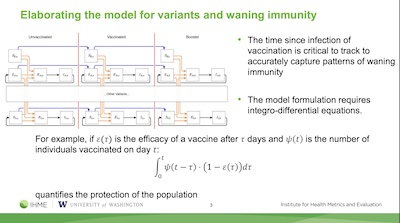
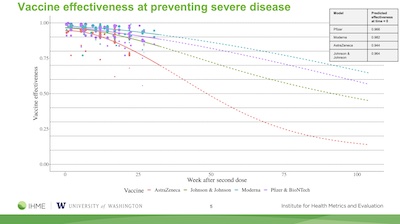
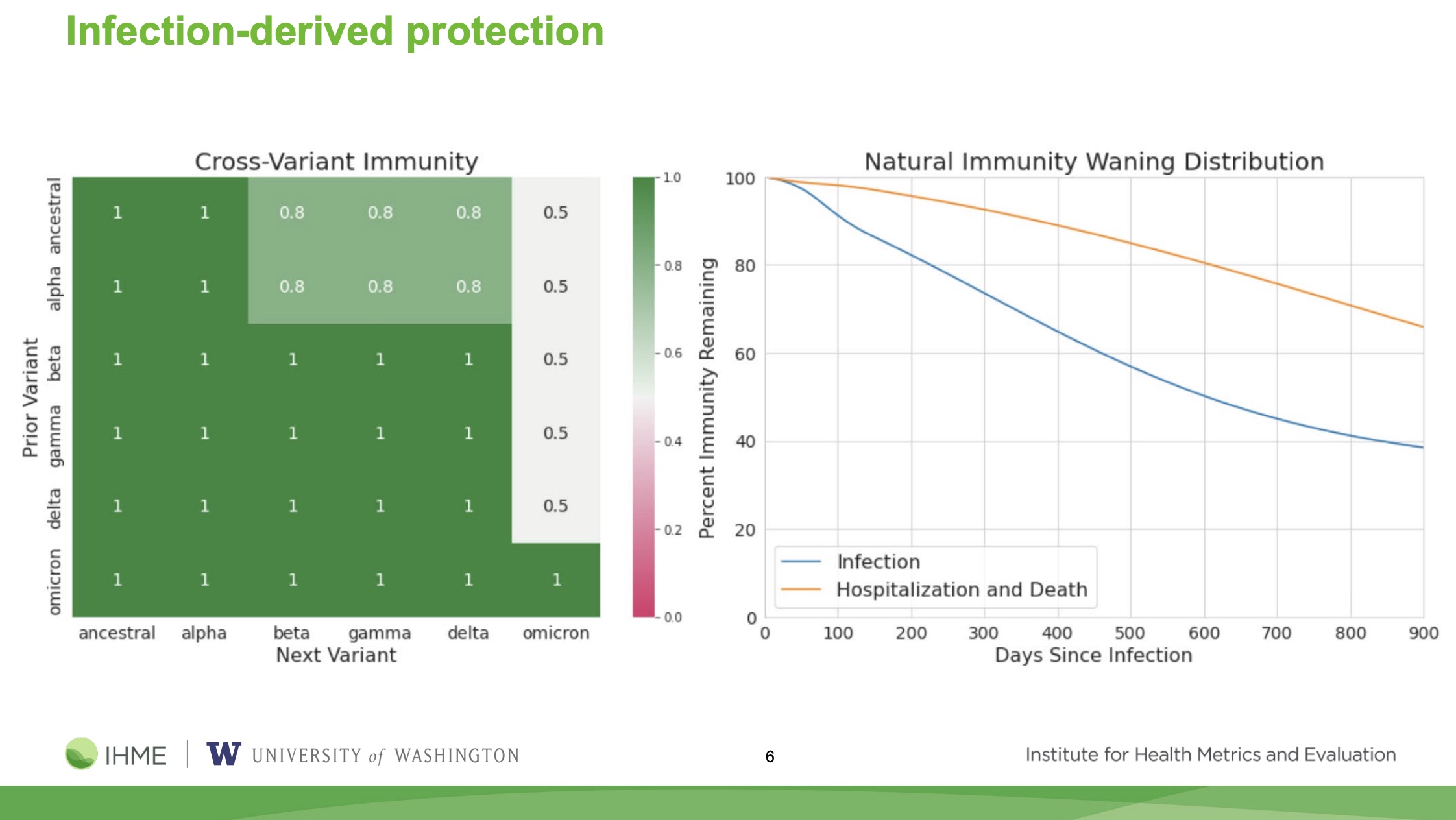 SIR models are a subspecies of compartmental models, in which one divides the population
into “compartments” like S usceptible, I mmune, and R ecovered. The various
plausible state transitions are drawn in with arrows. There’s a (nonlinear) differential
equation for the time rate of change each state, with a coupling constant and the product
of compartment populations on the right-hand side for each arrow. If there’s vaccine
waning with time, then you get an integro-differential equation, as shown here.
SIR models are a subspecies of compartmental models, in which one divides the population
into “compartments” like S usceptible, I mmune, and R ecovered. The various
plausible state transitions are drawn in with arrows. There’s a (nonlinear) differential
equation for the time rate of change each state, with a coupling constant and the product
of compartment populations on the right-hand side for each arrow. If there’s vaccine
waning with time, then you get an integro-differential equation, as shown here.
I’ve played with these a bit in the past. (Most recently, somewhat nervously in March 2020. It was a (minor) part of my decision to retire.) They’re a bit tricky: it’s tempting to add more state and arrows, but that adds more parameters and weird sensitivity to initial conditions or parameter variation. So I’m a bit taken aback by the complexity of the model shown here:
- 4 states (Susceptible, Exposed, Immune, and another flavor of Suceptible after fading immunity) for each of 3 populations (unvaccinated, vaccinated, and boosted).
- So that’s 12 states, then multiplied by the number of viral strains tracked: say 4 or so, for a total of around 48 states.
- I didn’t even try to count the arrows, of which there are many, but it’s easily a 100 parameter model. How on earth can you estimate that?
Still… it’s a brave attempt and we should (skeptically) evaluate how it works on historical data. (Regrettably, we now have a couple years of COVID-19 data.)
The second slide here shows, alas without math, the results integrating their model to estimate vaccine efficacy versus time. It’s… not a tight fit, but… neither is it utter nonsense. I’ve no idea how the did the model parameter estimation, but it seems to generate relatively reasonable results.
The third slide here seems out of place, but it’s interesting:
- The green matrix shows cross-immunity between strains. The critical part is the rightmost column: Omicron confers Omicron immunity, but everything else is only about half as good. So previous infection isn’t that great.
- The curves on the right show vaccine- and infection-derived immunity versus time. NB: infection immunity fades much faster. (So get vaccinated.)
They also did some fitting of their models to past data, the result of which seems to be relatively non-absurd fits. I didn’t dive into all the details here, because (a) their fits of VE waning convinced me the model, while complex, is not absurd, and (b) I’m more interested in their forecast for the future anyway.
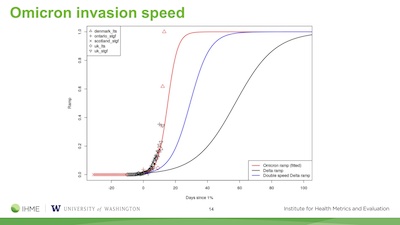 There’s a lot here about Omicron, but 2 things suffice:
There’s a lot here about Omicron, but 2 things suffice:
- The invasion speed, or the fraction of cases due to Omicron vs time shown here, is amazing (and not in a good way). The red curve here is the model’s estimate for Omicron, while the black and blue curves are Delta and double-speed Delta, respectively.
- Not reproduced here is a table of various vaccine efficacies vs various strains, showing that Omicron is worth taking very seriously, as we have found to our sorrow.
These are not so much predictions about Omicron, as model validation showing the model gives the same warnings we’ve encountered to our sorrow in reality.
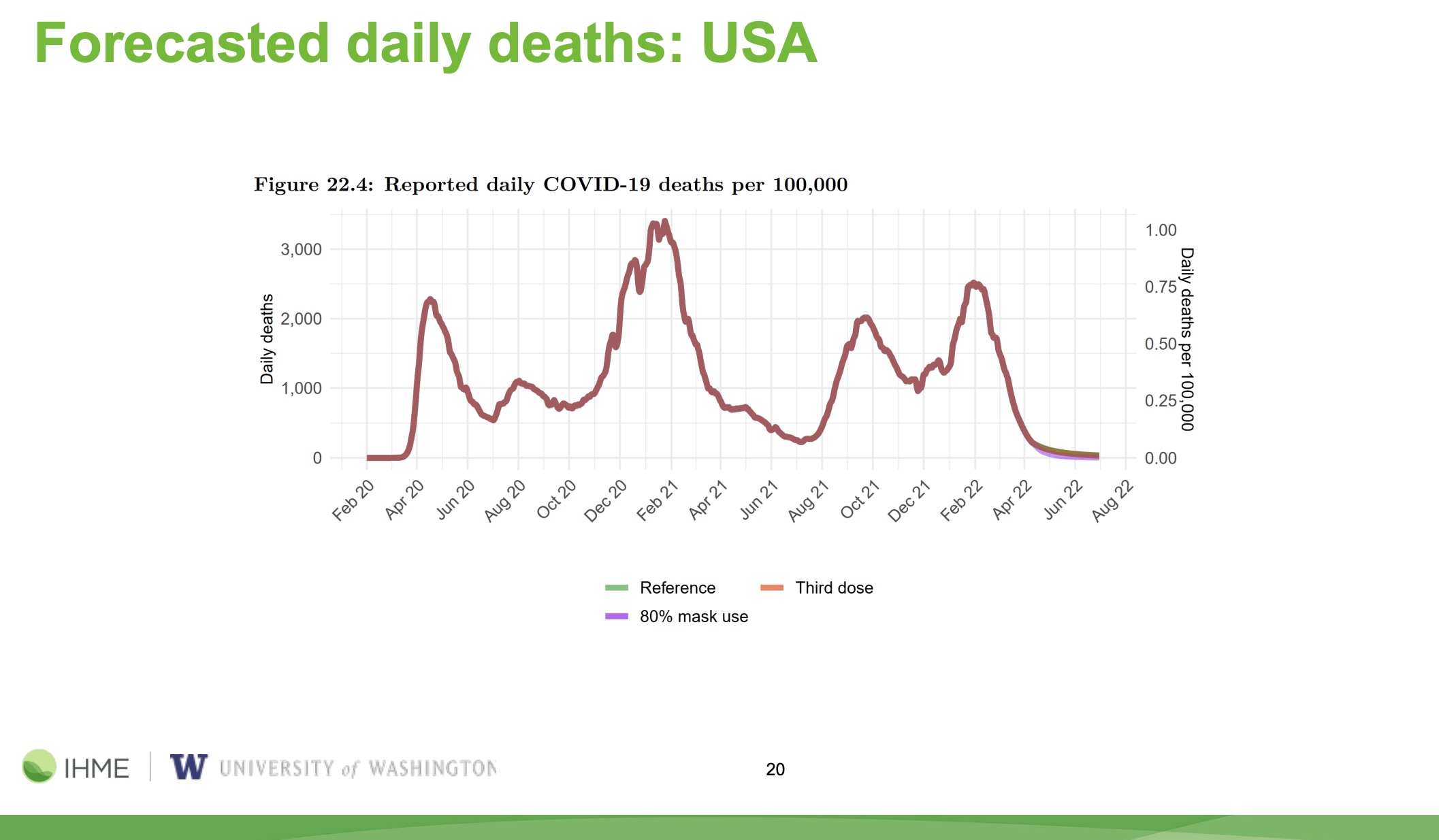 Finally, the main act: their forecast. Having shown the model is sensible, what does it
say about the future?
Finally, the main act: their forecast. Having shown the model is sensible, what does it
say about the future?
Despite the grimness of the Omicron past, the future looks… sort of ok?! Their forecast of the death rate in the US goes down to near-normal, mostly due to exhaustion of the susceptible population through vaccination or prior infection. We could have done better than that with aggressive vaccination mandates to save lives, but we chose to “tough it out” instead. It was indeed tough, but this (somewhat plausible?) model predicts that “the end is near”, this time in a good sense.
Immunity won’t last, of course, so we’l have to manage this chronically, perhaps forever. And there will be blow-back of new variants both from wild animal populations as well as the very human population in the developing world who are not yet vaccinated.
The IHME conclusion:
End of omicron wave will leave world with highest levels of immunity since the beginning of the pandemic. But immunity will wane.
I liked this talk! It was nicely mathematical, they showed they could credibly estimate the required parameters, they tested it on past data in a couple ways showing plausibility, and they made a definite prediction about the future. (Of course, it was a prediction I liked, so I should be suspicious of my judgement there.)
Protection by 4th Dose of BNT162b2 Against Omicron in Israel
The main act: the Israeli data on 2nd boosters from our now old friends, Alroy-Preis and Milo. They have ridiculously elite affiliations, with the Israeli Ministry of Health, the Weizmann Institute, the Technion, the Gertner Institute, and Hebrew University. Basically all the big, high-prestige institutions in Israel, which mean their opening slide was decorated with a hilarious number of high-prestige logos.
But on to the actual science.
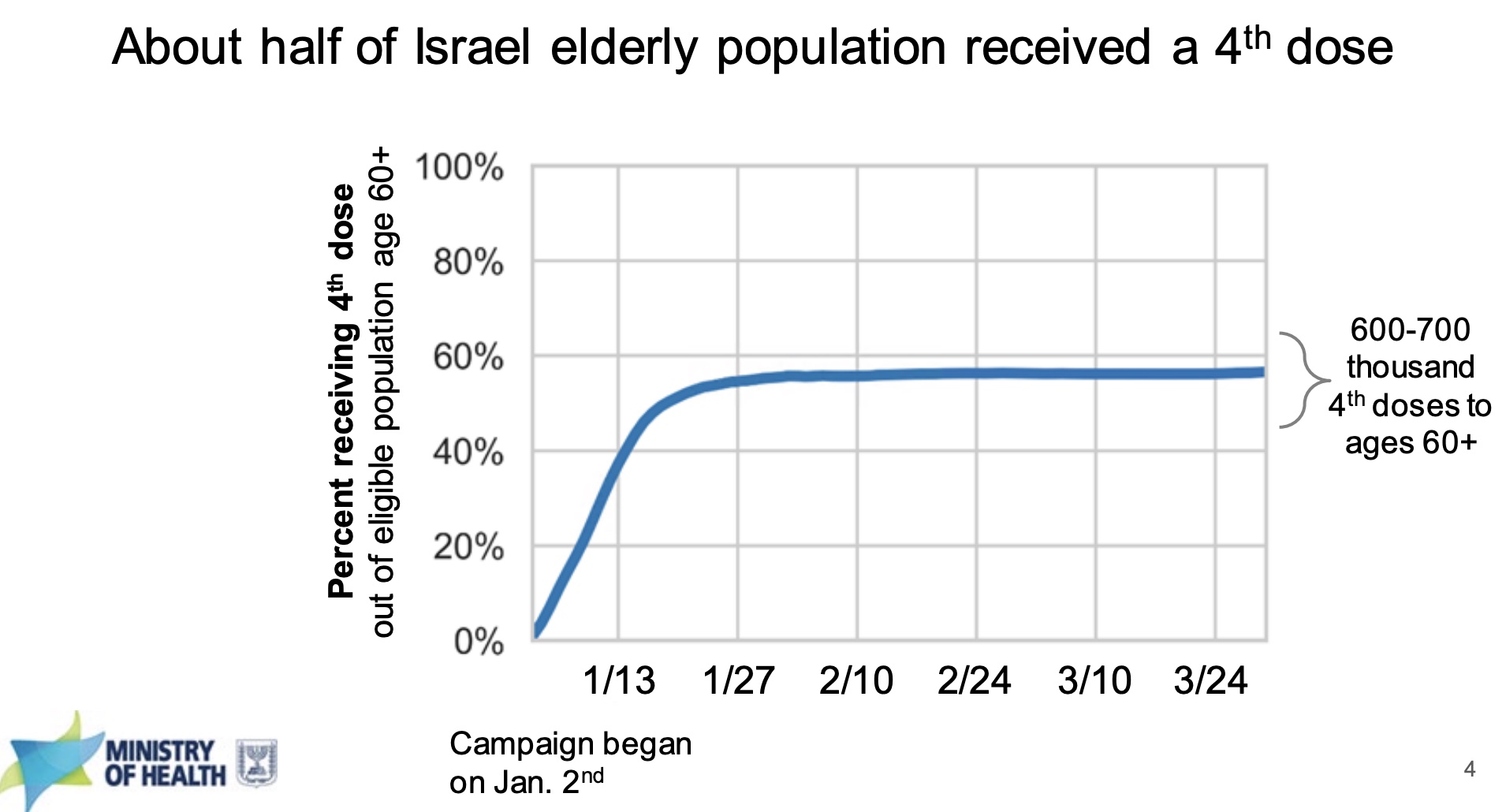 Because Israel, unlike the US, has actual universal health care and a unified electronic
medical records system, they can take a broad look at the whole population. Hence we have
here a “natural experiment”:
Because Israel, unlike the US, has actual universal health care and a unified electronic
medical records system, they can take a broad look at the whole population. Hence we have
here a “natural experiment”:
- 1.2 million people were eligible (age > 60 or medical staff, whose 3rd dose was > 4 months ago.
- About half chose to take a 4th dose, and half did not. As the time graph shows, the 4th dose cohort was exteremely rapid in uptake: about 3 weeks from start to saturation.
This is nice (600k people in each arm!), but of course it introduces problems from not being randomized. Perhaps the population taking the 4th dose was just medically more cautious, or took more COVID-19 precautions generally? That would mess up the result, and in a way we cannot resolve.
Other ways to be messed up have happened to Israeli “natural experiments” before, such as last year’s exercise with Simpson’s paradox we wrote about last August. Unsurprisingly, having been bitten by that, they’ve been extremely careful on each subsequent occasion. And so it is here: they mention about a half dozen times they’ve applied corrections for the things they can correct:
Adjusted for age, gender, sector, and calendar day using quasi-Poisson regression
It would be nicer if they gave the details, but that’s in the preprint of their paper and not in these summary slides. Since I haven’t read the preprint, I won’t complain further about not seeing the quasi-Poisson regression.
The bottom line on confounding factors seems to be that due to the volunteer effect, we can’t rule out bias that more careful people got second boosted and that would exaggerate the effect. Other biases were considered carefully, and we can spot them some credit that another iteration of Simpson’s paradox is not going to be a problem here.
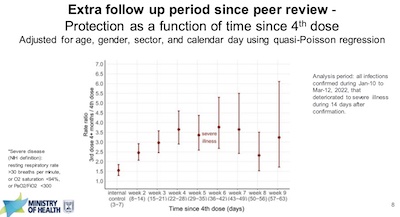 The results look pretty good! What’s shown here is the risk ratio for serious disease:
3-dose cohort / 4-dose cohort.
The results look pretty good! What’s shown here is the risk ratio for serious disease:
3-dose cohort / 4-dose cohort.
Recall that we expect this term, like the vaccine efficacy, to be distributed by a Gauss hypergeometric function ${}_{2}F_{1}()$. However, pretty much everybody uses a simpler binomial confidence interval to calculate confidence limits on such a risk ratio. We’d like to see the 95% confidence interval bounded above 1 to believe that the risk is higher for 3-dose then 4-dose people. It certainly looks like that, building to more or less equilibrium by 4 weeks. The error bars get a bit larger after that (the whole cohort didn’t get to week 9 by the time of readout), so it’s hard to say if there’s a waning effect or not… but maybe not?
Milo said the consensus was they bought another 2-fold to 4-fold further protection against mortality with the 2nd boosters.
So, yeah: 2nd boosters for people over 60 seem to work. Your humble Weekend Editor got second-boosted last week, so I’m looking forward to increased safety in the presence of Omicron.
You’d think, since I said this was “the main act”, there would be more to say. There’s more in their slides (population characteristics, myocarditis/pericarditis risk, and so on). But mostly it says things were ok and the 2nd boost worked.
Conclusions From Our Safari Guides
Ok, that’s a lot of data. But it all pulls in more or less similar directions:
- It’s hard to decide timing, strain match, multivalent vs monovalent.
- But so far, each booster has been a good strategy against Delta, and now against Omicron.
Our safari guides report from the discussion that the VRBPAC would like to see:
- More information on “correlates of protection” beyond antibody levels. There is data being collected on T-cell response, she said. Those data need to be presented to the committee.
- Data on safety. The public comment session included remarks by many people who said they had been injured by the vaccines. There are several systems put in place in the U.S. and elsewhere that are closely monitoring the safety of the vaccine. Those data need to be presented for the new vaccines in a granular way.
- What’s in the pipeline? Right now, the committee is considering only data from vaccines that have been authorized. But to decide on new variant vaccines, experts need to know what products are in the pipeline, even if they are not yet authorized.
All very reasonable, but also perhaps a product of the fact that this meeting had no voting issues and hence nothing to decide definitively, just advice for the future to the FDA. So of course they want more data.
So is it boosters forever? Probably not:
The FDA’s Marks, who announced the agency’s decision last week to authorize second boosters for certain groups, said he agreed that boosting people every four months wasn’t a long-term plan. In fact, he called the latest round of shots “a stopgap measure” until there was a better system in place to consider booster strategy more broadly. He said health authorities wanted to provide older adults, who’ve taken the brunt of Covid’s damage, with an extra layer of protection in the interim.
And as far as variant boosters, like the Omicron vaccines currently under development, apparently there’s a high bar for that:
Overall, this probably creates a high bar for new vaccines, either versions of the current mRNA vaccines from Pfizer and BioNTech that target different variants SARS-CoV-2 or combine more than one strain, or other technologies that might result in broader immunity. The FDA’s Peter Marks made clear that the agency does not see adding such a variant strain only as a booster – it would have to replace regular vaccinations in addition to boosters. And so that means the current vaccine would have to lose its effectiveness against hospitalization and that the new vaccine would have to be clearly better.
The Weekend Conclusion
Honestly, I dunno what to think after all that. On the one hand, the strain selection, timing, and polyvalent vs monovalent problems are daunting. On the other hand, the empirical evidence is that the boosters so far have worked well and been well timed mostly due to luck.
Luck is not a strategy.
I hope we get our vaccine booster, composition, and timing policies ironed out soon, while the adults are still nominally in charge in Washington.
Notes & References
1: FDA Advisory Committee Staff, “Vaccines and Related Biological Products Advisory Committee April 6, 2022 Meeting Announcement”, US Food & Drug Administration, 2022-Apr-06. ↩
2: FDA Advisory Committee Staff, “Considerations for COVID-19 Vaccine Booster Doses and Process for COVID-19 Vaccine Strain Selection to Address Current and Emerging Variants”, US Food & Drug Administration VRBPAC briefings, 2022-Apr-06. ↩
3: FDA Advisory Committee Staff, “Topics for VRBPAC Discussion”, US Food & Drug Administration VRBPAC briefings, 2022-Apr-06. ↩
4: DL Fink, “COVID-19 Vaccines: Framework for Future Decisions on Strain Composition and Use of Additional Booster Doses”, Office of Vaccines Research and Review/CBER/FDA, 2022-Apr-06. ↩
5: JP Weir, “Proposed Framework for Addressing Future COVID-19 Vaccine Strain Composition”, Division of Viral Products/OVRR/CBER/FDA, 2022-Apr-06. ↩
6: T Bedford, “Continuing SARS-CoV-2 evolution under population immune pressure”, Fred Hutchinson Cancer Center/HHMI, 2022-Apr-06. ↩
7: J Beigel, “SARS-CoV-2 Antigenic Space”, Natl Inst Allergy & Inf Dis, 2022-Apr-06. ↩
8: IHME Staff, “IHME COVID-19 update”, Inst for Health Metrics & Eval @ Univ Washington, 2022-Jan-18. ↩
9: S Alroy-Preis & R Milo, “Protection by 4th dose of BNT162b2 against Omicron in Israel”, Israeli MOH, Weizmann Institute, Gertner Institute, Hebrew Univ, Technion, 2022-Apr-01. ↩
10: K Subbarao, “Technical Advisory Group on COVID-19 Vaccine Composition (TAG-CO-VAC)”, World Health Organization, 2022-Apr-06. ↩
11: H Scobie, “Update on the Epidemiology of SARS-CoV-2 Strains”, US CDC, 2022-Apr-06. ↩
12: R Link-Gelles, “COVID-19 Vaccine Effectiveness in Children and Adults”, US CDC, 2022-Apr-06. ↩
13: R Johnson, “COVID-19 Vaccine Strain SelectionPoints to Consider for Manufacturing Timelines”, US Dept HHS, 2022-Apr-06. ↩
14: A Joseph & M Herper, “Tracking an FDA advisory panel meeting on Covid-19 vaccines and boosters”, STAT News, 2022-Apr-06. ↩

Gestae Commentaria
Comments for this post are closed pending repair of the comment system, but the Email/Twitter/Mastodon icons at page-top always work.